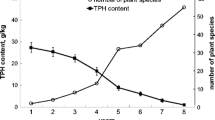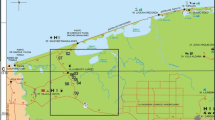Abstract
The study evaluated the impact of crude oil pollution on natural regeneration of plant species in a major oil-producing community in the Niger Delta region of Nigeria. Three sites—unpolluted site (US), polluted and untreated site (PUS), and polluted and treated site (PTS)—were purposively chosen for the study. The seedling emergence method was used to evaluate soil seed banks in the various sites at two depths, 0 to 10 cm and 10 to 20 cm. Woody-plant species richness, abundance, and diversity were higher in the US seed bank than in the PUS and PTS seed banks. The highest number of non-woody plants was observed in the US, followed by the PTS, and then the PUS. Both species richness and diversity of non-woody plants were highest at the US, followed by the PUS, and lowest in the PTS. Woody species in the US seed bank were 87.5% and 80% dissimilar with those of the PUS and PTS at 0–10 cm and 10–20 cm respectively. No variation was observed between woody species in the PUS and PTS seed banks. Non-woody species at 0–10 cm US seed bank were 73.08% dissimilar with those of PUS at the two soil depths and 81.48/88.46% dissimilar with those of the 0–10/10–20 cm of the PTS respectively. At 10–20 cm, non-woody species of the US were 69.66% dissimilar with those from each of the two soil depths in PUS; and 73.91/81.82% dissimilar with those of 0–10/10–20 cm of the PTS respectively. Non-woody species variation between the PUS and PTS was higher at 10–20 cm than 0–10 cm. The poor seed bank attributes at the polluted sites demonstrates that crude oil pollution negatively affected the natural regeneration potential of the native flora because soil seed banks serve as the building blocks for plant succession. Thorough remediation and enrichment planting are recommended to support the recovery process of vegetation in the polluted areas.
Similar content being viewed by others
References
ABB. 1997. ABB’s Environmental Management Report. ABB, Stockholm, 88pp.
Adam GI, Duncan H. 2002. Influence of diesel on seed germination. Environmental Pollution, 120: 363–370.
Baker JM 1970. The effects of oils on plants. Environmental Pollution, 1(1): 27–44
Butler BJ, Chazdon RL. 1998. Species richness, spatial variation and abundance of the soil seed bank of a secondary tropical rain forest. Biotropica 30: 214–222.
Degreef J, Rocha OJ, Vanderborght T, Baudoin J-P 2002. Soil seed bank and seed dormancy in wild populations of lima bean (Fabaceae); Considerations for in situ and ex situ conservation. American Journal of Botany, 89: 1644–1650.
Dereje A, Oba G, Weladji RB, Colman, JE. 2003. An assessment of restoration of biodiversity in degraded high mountain grazing land in northern Ethiopia. Land Degradation and Development, 14: 25–38.
De Villiers AJ, Van Rooyen, Theron GK. 2003. Similarity between the soil seed bank and the standing vegetation in the Strandveld Succulent Karoo, South Africa. Land degradation and Development, 14: 527–540.
Dorn PH, Salanitro J. 2000. Temporal ecology assessment of oil contaminated soils before and after bioremediation Chemosphere, 40(4): 419–426.
Garwood NC. 1989. Tropical soil seed bank, a review. In: Leck, M.A., Parker, V.T. and Simpson, R.L. (eds.), Ecology of Soil Seed Banks. San Diego, CA, US: Academic Press, pp.149–209.
Ihenyen J, Mensah JK, Okoegwale EE. 2010. Tree/shrubs species diversity of Ehor Forest Reserve in Uhunmwode Local Government Area of Edo State, Nigeria. Researcher. 2(2): 37–49.
Jalili A, Hamzeh’ee Y, Asri A, Shirvany S, Yazdani, M, Khoshnevis F, Zarrinkamar M, Ghahramani R, Safavi S, Shaw J, Hodgson K, Thompson M, Akbarzadeh, Pakparvar. 2003. Soil seed bank in the Arasbaran protected area of Iran and their significance for conservation management. Biological Conservation, 109: 425–431.
Kebrom T, Tesfaye B. 2000. The role of seed banks in the rehabilitation of degraded hill slopes in Southern Wello. Biotropica, 32: 23–32.
Lunt ID. 1997. Germinable soil seed banks of anthropogenic native grasslands and grassy forest remnants in temperate south-Eastern Australia. Plant Ecology, 130: 21–34.
Michel J, Henry Jr CB, Thumm S. 2002. Shoreline assessment and environmental impacts from the M/T Westchester Oil Spill in the Mississippi River. Spill Science & Technology Bulletin, 7(3–4): 155–161.
Michel J, Trevor G, Waldron J, Blocksisidge CT, Etkin DS, Urban R. 2005. Potentially polluting wrecks in marine waters. In: Annals of the 2005 International Oil Spill Conference, pp. 1–84. Maio 16, Miami.
NDES. 2001. Biological Environmental Research Report. RSUST, Port Harcourt. Volume 46. 251pp.
Odum EP. 1971. Fundamentals of Ecology. W.B. Saunders Company, Philadephia, 574pp.
Ogbo EM, Zibigha M, Odogu G. 2009. The effect of crude oil on growth of the weed (Paspalum crobiculatum L.) — phytoremediation potential of the plant, African Journal of Environmental Science and Technology, 3(9): 229–233.
Ogunleye AJ, Adeola AO, Ojo LO, Aduradola AM. 2004. Impact of farming activities on vegetation in Olokemeji Forest reserve, Nigeria, Global Nest, 6(2): 131–140.
Ojo LO 2004. The fate of a tropical rainforest in Nigeria: Abeku sector of Omo Forest Reserve, Global Nest, 6(2): 116–130.
Oke SO, Ayanwale TO, Isola OA. 2007. Soil seedbank in four contrasting plantations in Ile-Ife area of Southwestern Nigeria. Resource Journal of Botany, 2: 13–22.
Port Harcourt Appeal Court. 1994. Report of Case between SPDC Nigeria Limited (Appellant/Defendant) and the Kegbara Dere People (Respondents/Plaintiffs).
Powell R. 1997. The use of plants as “Field” biomonitors. In: Wang, W. Gorsuch, J. and Hughes, J. (eds.), Plants for Environmental Studies. Boca Raton: Lewis, pp. 47–61
Senbeta F, Taketay D. 2002. Soil seed banks in plantations and adjacent natural dry Afromontane forests of central and southern Ethiopia. Tropical Ecology, 43(2): 229–242.
Simpson EH. 1949. Measurement of diversity, Nature, 163: 688
Tefera M, Demel T, Hulten H, Yemshaw Y. 2005. The role of enclosures in the recovery of woody vegetation in degraded dryland hillsides of central and northern Ethiopia. Journal of Arid Environment, 60: 259–281.
Wassie A, Teketay D. 2006. Soil seed banks in church forests of northern Ethiopia: Implications for the conservation of woody plants. Flora, 201: 32–43.
Williams-Linera G. 1993. Soil seed bank in four low mountain forests of Mexico. Journal of Tropical Ecology, 9: 321–337.
Author information
Authors and Affiliations
Corresponding author
Rights and permissions
About this article
Cite this article
Chima, U.D., Vure, G. Implications of crude oil pollution on natural regeneration of plant species in an oil-producing community in the Niger Delta Region of Nigeria. Journal of Forestry Research 25, 915–921 (2014). https://doi.org/10.1007/s11676-014-0538-y
Received:
Accepted:
Published:
Issue Date:
DOI: https://doi.org/10.1007/s11676-014-0538-y




